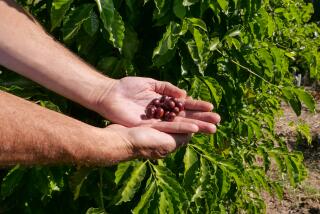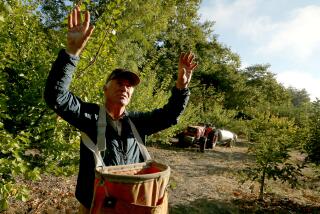Farmers Markets: Fresh sour cherries are hard to find
Of all the rare fruit at Southern California markets, none is more elusive or more obsessively hunted than the humble sour cherry. The fruit is readily available canned or frozen, but these days bakers, jam makers and home cooks really want fresh. And though sweet cherries have become commonplace, sours, which are also called tart or pie cherries, are hardly grown here at all.
In fact, they’d be virtually unobtainable were it not for one little-known farm in Utah that will provide more than 90% of the local supply. But thanks to Robert McMullin, a farmer in Utah, sour cherries will be available here for the next couple of weeks, even if only at a few local grocers and some Whole Foods markets.
Most of the tart cherries grown in the United States come from Michigan — there are fewer than 10 acres in California. That’s mainly because of the weather. Compared with sweet cherry trees, sour cherry trees are much more cold hardy, and so they are more commonly grown in areas with frigid winters, such as Russia, Eastern Europe and the Midwest. We never get cold enough in the lowlands, we have too many spring freezes in the mountains and there’s too much heat during harvest. The biggest farm here has just 3 acres.
There used to be several U-Pick plantings in the mountains north of Los Angeles — a springtime excursion for cherry picking was a ritual for many — but as the trees and owners got older, most of the outlets have closed.
So when one of the rare California growers, such as the legendary Circle C Ranch from near Lake Hughes, brings sour cherries to the Hollywood farmers market, “there isn’t a stick big enough to fight off all the customers,” says manager Alexandra Agajanian.
Sour cherries have a fascinating lineage. They’re actually from a different species than sweet cherries such as Bing. They’re a natural hybrid of sweet cherry with ground cherry, a cold-hardy bush that bears tiny, very tart and astringent fruit.
Compared with sweet cherries, sour cherries are smaller and softer, with acidity, flavor of the stone and a slight bitterness that shine through when cooked. They are indispensable for making pie, preserves, soup, brandy and albaloo polo, a Persian rice dish. Recently, tart cherry juice and dried fruit have become popular, as medical studies have shown that the fruit may have anti-inflammatory and disease-fighting properties.
A century ago, Midwestern farmers grew dozens of varieties of sour cherries, but today, 99% of the domestic crop is of one centuries-old French type called Montmorency, and almost all of the harvest is processed. Because sour cherries are so delicate and because of quarantine restrictions for pests, fresh sour cherries from the Midwest rarely reach California markets.
McMullin Orchards, in the foothills near Payson, Utah, south of Provo, grows a variety called Balaton, which is not much favored by the processing industry. Trying to find a market, three years ago it started sending truckloads of fruit to Shapiro, Gilman & Shandler, a Los Angeles produce distributor.
Because of the hot, arid climate, Utah-grown cherries are higher in sugar than those from Michigan. Late-harvested, fully ripe Balatons can reach 24 degrees Brix (a measure of sweetness) and are delicious to eat fresh, but many Persians and other ethnic customers prefer them tart, around 18 degrees Brix. “If we pick them too sweet, they complain,” said McMullin.
Harvest is painstaking. The cherries have to be hand-picked so they keep their stems and don’t leak or spoil. The fruit is soft and must be handled gently.
Still, this season McMullin plans to send 80 tons of cherries to the Los Angeles area, where they can be bought mostly at Persian, Armenian and Latino groceries for $4 to $8 a pound.
There is hope for the future for California, though. Next year a young 1-acre orchard planted by Murray Family Farms near Bakersfield should start bearing and will make local sour cherries available again. An end to frustration for Southern California sour cherry fanatics may be at hand.
More to Read
Eat your way across L.A.
Get our weekly Tasting Notes newsletter for reviews, news and more.
You may occasionally receive promotional content from the Los Angeles Times.










